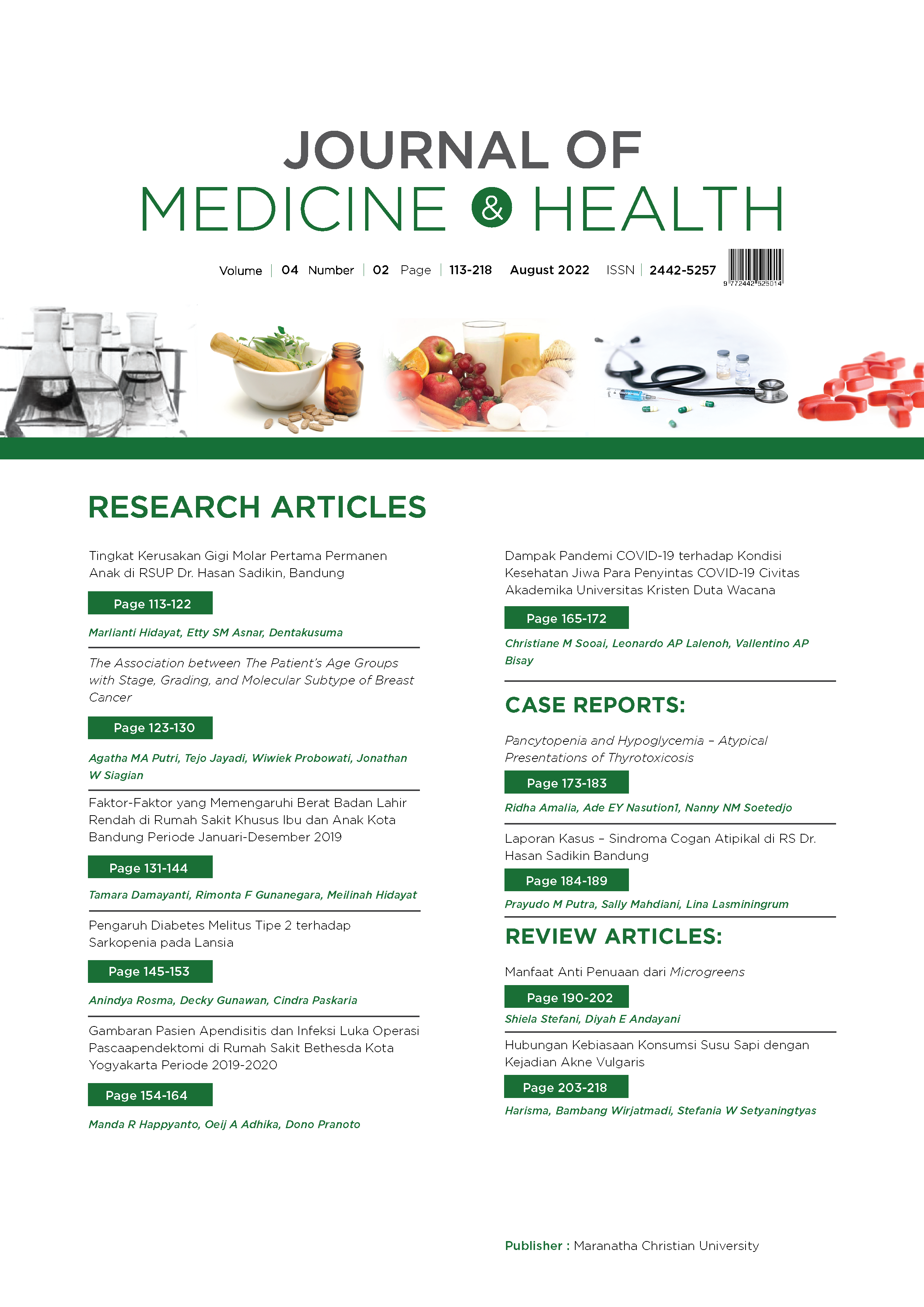Manfaat Anti Penuaan dari Microgreens
DOI:
https://doi.org/10.28932/jmh.v4i2.3887Keywords:
microgreens, anti penuaan, stres oksidatif, polifenolAbstract
Penuaan adalah proses hilangnya fungsi jaringan dan organ yang terjadi secara progresif, salah satunya akibat akumulasi stres oksidatif. Terapi antioksidan dapat membantu dalam mengatasi stres oksidatif dan mencegah terjadinya penuaan dini. Microgreens mengandung vitamin dan fitokimia yang bekerja sebagai antioksidan dan anti-inflamasi. Tujuan penulisan telaah pustaka ini adalah untuk mengidentifikasi kandungan nutrisi di dalam microgreens dan efeknya terhadap penuaan. Metode penelitian ini adalah tinjauan pustaka dari semua literatur mengenai manfaat anti penuaan dari microgreens yang dipublikasi dalam 10 tahun terakhir hingga tahun 2021. Hasil penelitian ini didapatkan bahwa vitamin dan fitokimia yang terdapat dalam microgreens lebih tinggi dibandingkan tanaman maturnya. Microgreens mengandung vitamin A, C, dan E serta polifenol yang memiliki efek antioksidan dan anti-inflamasi. Hal ini mungkin memberikan keuntungan untuk memperlambat penuaan. Kesimpulan dari penulisan telaah pustaka ini adalah kandungan vitamin dan fitokimia dalam microgreens mungkin berperan dalam menghambat proses penuaan, namun pengetahuan mengenai manfaat anti penuaan dari microgreens masih sangat terbatas. Diperlukan penelitian mengenai pengaruh kandungan vitamin, mineral, dan fitokimia pada berbagai microgreens terhadap kesehatan dan sebagai anti penuaan, terutama secara in vivo.Downloads
References
Liguori I, Russo G, Curcio F, Bulli G, Aran L, Della-Morte D, et al. Oxidative stress, aging, and diseases. Clin Interv Aging. 2018;13:757–72.
Ferrucci L, Gonzalez?Freire M, Fabbri E, Simonsick E, Tanaka T, Moore Z, et al. Measuring biological aging in humans: A quest. Aging Cell. 2020;19(2):e13080–100.
Kementerian Kesehatan Republik Indonesia. Analisis Lansia di Indonesia. 2017.
Tan BL, Norhaizan ME, Liew WPP, Sulaiman Rahman H. Antioxidant and oxidative stress: a mutual interplay in age-related diseases. Frontiers in pharmacology. 2018;9:1162–89.
Harvard NeuroDiscovery Center. The challenge of neurodegenerative diseases. 2022 [cited 2022 Feb 22]. Available from: https://neurodiscovery.harvard.edu/challenge#:~:text=Neurodegenerative%20diseases%20occur%20when%20nervous,result%20in%20the%20cells'%20demise.
Alzheimer’s Indonesia. Statistik tentang dementia. 2019 [Cited 2022 Feb 22]. Available from: https://alzi.or.id/statistik-tentang-demensia/.
Gioia F Di, Tzortzakis N, Rouphael Y, Kyriacou MC, Sampaio SL, Ferreira ICFR, et al. Grown to be blue—antioxidant properties and health effects of colored vegetables. Part ii: Leafy, fruit, and other vegetables. Antioxidants. 2020;9(2):1–42.
Lin YK, Kao YY, Liu C, Liang CH, Lin YH, Hu WC, et al. Effects of a fermented grape combined with specified fruits and vegetables or their extracts on anti-aging and anti-inflammatory status: a randomized controlled clinical trial. J Food Nutr Res. 2021;9(6):292–6.
Amat-Ur-rasool H, Symes F, Tooth D, Schaffert LN, Elmorsy E, Ahmed M, et al. Potential nutraceutical properties of leaves from several commonly cultivated plants. Biomolecules. 2020;10(11):1–22.
Galieni A, Falcinelli B, Stagnari F, Datti A, Benincasa P. Sprouts and microgreens: Trends, opportunities, and horizons for novel research. Agronomy. 2020;10(9):1424.
Lester G, Xiao Z, Wang Q. Microgreens: assessment of nutrient concentrations. Agric Food Chem. 2013;60(3):7644–51.
Sharma A, Rasane P, Dey A, Singh J, Kaur S, Dhawan K, et al. Optimization of a process for a microgreen and fruit based ready to serve beverage. Int J Food Stud. 2021;10:SI41–56.
Patel DK. Microgreens: Micro-scale vegetable production & a new beginning towards nutrition and livelihood in urban-periurban and rural area. Agriculture & food e-newsletter. 2020;2(4):71–5.
Le TN, Chiu CH, Hsieh PC. Bioactive compounds and bioactivities of brassica oleracea l. var. italica sprouts and microgreens: an updated overview from a nutraceutical perspective. Plants. 2020;9(8):946–69.
Lenzi A, Orlandini A, Bulgari R, Ferrante A, Bruschi P. Antioxidant and mineral composition of three wild leafy species: a comparison between microgreens and baby greens. Foods. 2019;8(10):487–506.
Johnson SA, Prenni JE, Heuberger AL, Isweiri H, Chaparro JM, Newman SE, et al. Comprehensive evaluation of metabolites and minerals in 6 microgreen species and the influence of maturity. Curr Dev Nutr. 2021;5(2):1–12.
Kyriacou MC, El-Nakhel C, Soteriou GA, Graziani G, Kyratzis A, Antoniou C, et al. Preharvest nutrient deprivation reconfigures nitrate, mineral, and phytochemical content of microgreens. Foods. 2021;10(6):1333–48.
Truzzi F, Whittaker A, Roncuzzi C, Saltari A, Levesque MP, Dinelli G. Microgreens: functional food with antiproliferative cancer properties influenced by light. Foods. 2021;10(8):1690–110.
Choe U, Yu LL, Wang TT. The science behind microgreens as an exciting new food for the 21st century. J Agric Food Chem. 2018;66(44):11519–30.
Xiao Z, Lester GE, Luo Y, Wang Q. Assessment of vitamin and carotenoid concentrations of emerging food products: edible microgreens. J Agric Food Chem. 2012;60(31):7644–51.
Zhang Y, Xiao Z, Ager E, Kong L, Tan L. Nutritional quality and health benefits of microgreens, a crop of modern agriculture. J Futur Foods. 2021;1(1):58–66.
Mir SA, Shah MA, Mir MM. Microgreens: Production, shelf life, and bioactive components. Crit Rev Food Sci Nutr. 2017;57(12):2730–6.
Swaraj Agarwal. Benefits of microgreens how are microgreens effective in boosting immunity and protecting against cancer. Int J Trend Sci Res Dev. 2020;4(6):156–8.
Gan RY, Lui WY, Wu K, Chan CL, Dai SH, Sui ZQ, et al. Bioactive compounds and bioactivities of germinated edible seeds and sprouts: An updated review. Trends Food Sci Technol. 2017;59:1–14.
Chen Y, Chen J, Wang R. Study on the anti-aging physiological characteristics and molecular mechanism of camellia oleifera. Research Square. 2021;1(1):1–18.
Tan L, Nuffer H, Feng J, Kwan SH, Chen H, Tong X, et al. Antioxidant properties and sensory evaluation of microgreens from commercial and local farms. Food Sci Hum Wellness. 2020;9(1):45–51.
Haytowitz D, Lemar L, Pehrsson P, Exler J, Patterson K, Thomas R, et al. USDA national nutrient database for standard reference, release 24. US Department of Agriculture: Washington, DC, USA. 2011.
Ulla H, Antti K, Oskar L, Mari S. Genetic basis of flavor sensitivity and food preferences. In: Flavor. Woodhead Publishing. Elsevier; 2016. p 203–27.
Stefani S, Ngatidjan S, Paotiana M, Sitompul KA, Abdullah M, Sulistianingsih DP, et al. Dietary quality of predominantly traditional diets is associated with blood glucose profiles, but not with total fecal bifidobacterium in indonesian women. PloS one. 2018;13(12):e0208815–33.
Siskawardani DD, Winarsih S, Khawwee K. The antioxidant activity of kelor (moriga oleifera lam) leaves based on drying methods. Jordan J Biol Sci. 2021;14(2):291–5.
Gunathilake KDPP, Somathilaka Ranaweera KKD, Vasantha Rupasinghe HP. Effect of different cooking methods on polyphenols, carotenoids and antioxidant activities of selected edible leaves. Antioxidants. 2018;7(9):1–12.
Kim DE, Shang X, Assefa AD, Keum YS, Saini RK. Metabolite profiling of green, green/red, and red lettuce cultivars: Variation in health beneficial compounds and antioxidant potential. Food Res Int. 2018;105:361–70.
Kregel KC, Zhang HJ. An integrated view of oxidative stress in aging: basic mechanisms, functional effects, and pathological considerations. Am J Physiol Integr Comp Physiol. 2007;292(1):R18–36.
Serino A, Salazar G. Protective role of polyphenols against vascular inflammation, aging and cardiovascular disease. Nutrients. 2019;11(1):53–75.
Luo J, Mills K, le Cessie S, Noordam R, van Heemst D. Ageing, age-related diseases and oxidative stress: What to do next? Ageing Res Rev. 2020;57:100982.
Zampino M, Brennan NA, Kuo PL, Spencer RG, Fishbein KW, Simonsick EM, et al. Poor mitochondrial health and systemic inflammation? Test of a classic hypothesis in the Baltimore Longitudinal Study of Aging. GeroScience. 2020;42(4):1175–82.
Bottazzi B, Riboli E, Mantovani A. Aging, inflammation and cancer. Elsevier; 2018;40(1):74–82.
Santos AL, Sinha S. Obesity and aging: molecular mechanisms and therapeutic approaches. Ageing Res Rev. 2021;67(1):101268.
Dattola A, Silvestri M, Bennardo L, Passante M, Scali E, Patruno C, et al. Role of vitamins in skin health: a systematic review. Curr Nutr Rep. 2020;9(3):226–35.
Kemenkes RI. Angka kecukupan gizi yang dianjurkan untuk masyarakat indonesia. Jakarta: Kementerian Kesehatan Republik Indonesia; 2019.
Ahmad T, Cawood M, Iqbal Q, Ariño A, Batool A, Tariq RMS, et al. Phytochemicals in daucus carota and their health benefits. Foods. 2019;8(9):424–46.
Yang F, Suo Y, Chen D, Tong L. Protection against vascular endothelial dysfunction by polyphenols in sea buckthorn berries in rats with hyperlipidemia. Biosci Trends. 2016:1–9.
Moreira-Rodríguez M, Nair V, Benavides J, Cisneros-Zevallos L, Jacobo-Velázquez DA. UVA, UVB light, and methyl jasmonate, alone or combined, redirect the biosynthesis of glucosinolates, phenolics, carotenoids, and chlorophylls in broccoli sprouts. Int J Mol Sci. 2017;18(11):2330–50.
Argüelles S, Guerrero?Castilla A, Cano M, Muñoz MF, Ayala A. Advantages and disadvantages of apoptosis in the aging process. Ann N Y Acad Sci. 2019;1443(1):20–33.
Luo J, Si H, Jia Z, Liu D. Dietary anti-aging polyphenols and potential mechanisms. Antioxidants. 2021;10(2):283–102.
Huang H, Jiang X, Xiao Z, Yu L, Pham Q, Sun J, et al. Red cabbage microgreens lower circulating low-density lipoprotein (LDL), liver cholesterol, and inflammatory cytokines in mice fed a high-fat diet. J Agric Food Chem. 2016;64(48):9161–71.
Turner, E.R., Luo, Y. and Buchanan, R.L. Microgreen nutrition, food safety, and shelf life: a review. J Food Sci. 2020;85(4):870–82.
Ferreira MS, Magalhães MC, Oliveira R, Sousa-Lobo JM, Almeida IF. Trends in the use of botanicals in anti-aging cosmetics. Molecules. 2021;26(12):1–18.
Tungmunnithum D, Thongboonyou A, Pholboon A, and Yangsabai A. Flavonoids and other phenolic compounds from medicinal plants for pharmaceutical and medical aspects: an overview. Medicines. 2018;5(3):93–109.
Hano C and Tungmunnithum D. Plant polyphenols, more than just simple natural antioxidants: oxidative stress, aging and age-related diseases. Medicines. 2020;7(5):26–35.
Downloads
Published
How to Cite
Issue
Section
License
Copyright (c) 2022 Shiela Stefani, Diyah E Andayani

This work is licensed under a Creative Commons Attribution-NonCommercial 4.0 International License.
Authors who publish with this journal agree to the following terms:
- Authors retain the copyright and grant the journal right of first publication with the work
simultaneously licensed under a Creative Commons Attribution-NonCommercial 4.0 International License that allows others to share the work with an acknowledgement of the work's authorship and initial publication in this journal. - Authors are able to enter into separate, additional contractual arrangements for the nonexclusive distribution of the journal's published version of the work (e.g., post it to an institutional repository or publish it in a book), with an acknowledgement of its initial publication in this journal.
 This work is licensed under a Creative Commons Attribution-NonCommercial 4.0 International License.
This work is licensed under a Creative Commons Attribution-NonCommercial 4.0 International License.















